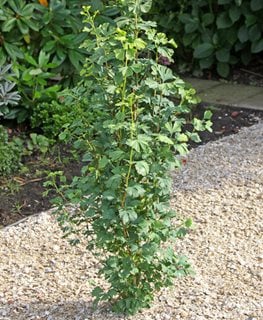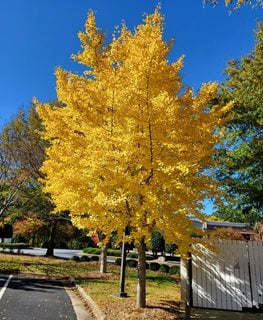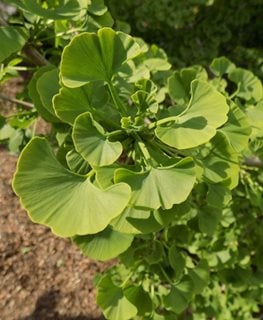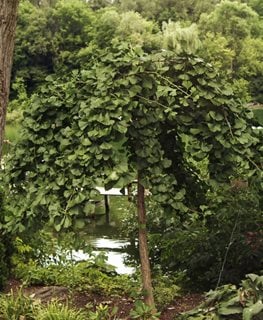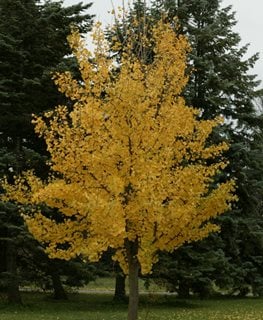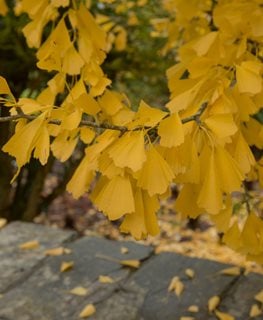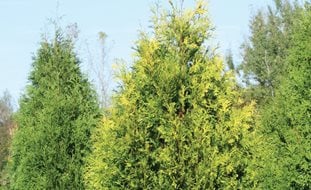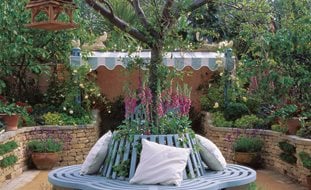How to Grow & Care For Ginkgo Trees
Learn about this intriguing prehistoric tree and how to use it in your yard.One of the oldest living trees, Ginkgo biloba dates back over 200 million years, and is referred to as a “living fossil.” Native to China, these long-lived trees are revered in Asian cultures and religions, and are often found in palace and temple gardens. Extracts from the leaves are thought to have various health benefits including memory enhancement, and are widely used in traditional Chinese medicine. Ginkgo biloba is the only surviving species of Ginkgoaceae, the Ginkgo family. Individual specimens can reach up to 100 feet tall, and have been known to live for 1,000 years or more.
This intriguing tree is classified as a conifer, even though it loses its leaves in fall. Ginkgos are dioecious, with separate male and female trees. The unique leaves that resemble tiny fans turn brilliant yellow for several weeks in fall before they are quickly shed, leaving a carpet of gold on the ground. The foliage resembles the leaflets of maidenhair fern, hence the common name of maidenhair tree.
Ginkgo biloba trees are disease-resistant, low maintenance, and forgiving of different growing conditions. Their pollution resistance and salt tolerance makes ginkgo trees a good choice for urban environments. Many cultivars have been bred for a smaller stature more suited to home gardens. Varieties come in various sizes and shapes, with different shades of green or variegated foliage. Here’s how to grow and use ginkgo trees in your yard.
On this page: Basics | Planting | Care | Varieties | Frequently Asked Questions
- BASICS
- HOW TO PLANT GINKGO
- GINKGO TREE CARE
- GINKGO VARIETIES
- FREQUENTLY ASKED QUESTIONS
- DESIGN IDEAS
BASICS
Botanical name:
Ginkgo biloba
Common names:
Ginkgo, maidenhair tree, fossil tree
Plant type:
Deciduous conifer tree
Zones:
3-9
Exposure:
Full sun to partial shade
Growth habit:
Upright, spreading, rounded, columnar, or dwarf habit
Height/spread:
50 to 80 feet tall or more, 30 to 40 feet wide. Dwarf varieties are smaller.
Bloom time:
Spring
Foliage:
Fan-shaped leaves 2 to 4 inches wide are two-lobed, with distinct veining that extends from top to bottom. Leaves emerge green or variegated in spring, with brilliant fall foliage in colors of yellow and gold.
Flowers:
Ginkgos are classified as non-flowering gymnosperm plants. Male trees have tassel-like green cones bearing pollen that occur in clusters along the branches. Females produce green shoots in vase-shaped clusters that appear alongside new leaves in spring. Once fertilized, the slender tubular shoots develop small rounded fruits at the tip.
Fruit:
Female trees produce small fleshy green fruits that ripen to an apricot color. The cherry-like fruits, which contain a single nut-like seed, drop to the ground and split open, exuding an offensive odor variously described as vomit, dog waste, or rancid butter. Dropped fruits have a slimy texture and become slippery when squashed. Because the fruits are messy and odorous, most garden cultivars sold at nurseries and garden centers are male only.
Bark:
The gray bark has a rough texture, becoming more deeply furrowed with age.
Are Ginkgo trees deer resistant?
Ginkgo trees are resistant to deer browse, though deer will eat almost any plant if they are hungry enough.
Are Ginkgo trees poisonous?
Male trees are considered non-toxic to pets and children. The fleshy outer layer of the female fruits may cause skin irritation or an allergic reaction in some people. Seeds, which are edible when cooked, contain a neurotoxin called ginkgotoxin, which can be harmful to humans and pets if ingested in large quantities.
PLANTING GINKGO
When to plant:
Plant during cooler months in spring or fall to avoid heat stress. Wait until all danger of frost is past in your area.
Where to plant:
Choose a site with well-draining soil and at least 6 hours of full sun per day.
How to plant:
Loosen soil in the planting area and amend with compost or other organic matter to improve soil and drainage. Dig a hole twice as wide and slightly shallower than the root ball. Remove the plant from its nursery pot and gently tease out roots if they are potbound. Place in the hole so the top of the root ball is slightly above the surrounding soil. Fill in the planting hole with soil and gently tamp down; water well to remove air pockets.
Apply a thin layer of mulch around the base of plants to suppress weeds, retain moisture and keep the root zone cool. Water plants regularly until established.
Spacing:
Space plants 3 to 40 feet apart, depending on the variety, to allow for full mature width.
GINKGO CARE
Temperature and humidity:
Ginkgo is cold tolerant once established, and may struggle in extreme heat. Plants do best in average humidity between 40 to 60 percent.
Soil:
Ginkgo is tolerant of acid or alkaline pH levels and different soils, including compacted soil. Plants perform best in well-draining sandy or loamy soil with a pH of 5.0 to 8.0. Poor drainage can cause root rot.
Watering:
Provide moderate moisture. Ginkgo is drought tolerant once established. Overwatering can lead to root rot. Provide supplemental water in extreme heat or dry spells if plants are exhibiting signs of stress.
Amendments and fertilizer:
Young trees will benefit from fertilizing to encourage new growth. Apply a slow-release fertilizer in spring that is especially formulated for trees and shrubs according to package instructions. Mature trees need no supplemental fertilizer.
Pruning and deadheading:
Ginkgo trees require minimal pruning. In late winter to early spring before new leaves emerge, remove dead, diseased or broken branches, and lightly shape plants. Thin out the crown as needed to improve air circulation. Slowly remove lower side branches over time to create a strong central leader.
Pests and diseases:
When grown in the right conditions, Ginkgo is resilient to most pests and diseases. Pests include aphids, ginkgo leafminer, looper caterpillars, and root knot nematodes. Diseases include anthracnose, bacteria canker, leaf spot, root rot, and root gall caused by root knot nematodes.
GINKGO VARIETIES
FREQUENTLY ASKED QUESTIONS
Why is the ginkgo tree special?
Ginkgo biloba is the oldest living tree species, dating back over 200 million years. These ancient trees have a lifespan of hundreds of years.
Which ginkgo trees have fruit?
Ginkgo trees are dioecious, with separate male and female plants. Female ginkgo plants produce fruit, while male plants do not. Because the fruits have a strong odor and are messy, most varieties sold to home gardeners are male.
How do I tell if my tree is male or female?
Most ginkgo trees sold at nursery and garden centers are male. In spring, female trees develop slender upright green shoots along the branches, while males have drooping catkin-like cones. Named cultivars are male; seedling-grown trees can be either male or female.
What are the cons of growing ginkgo trees?
Ginkgo trees may outgrow their space if not selected properly. Choose dwarf and smaller varieties if you live on a smaller property. Avoid female plants, which can produce messy, odorous fruit.
GINKGO BILOBA LANDSCAPING TIPS
For borders and landscapes:
Ginkgo can be planted as a street tree, lawn specimen, as screening along a property line, or as a focal point in a bed or border.
For slopes and hillsides:
Planted along a slope, ginkgo tree may help reduce erosion.
For containers:
Dwarf Ginkgo varieties can be planted in containers.
There are many ways to use ginkgo trees in your landscape. Here’s how:
- Plant a columnar variety in a row along a property line.
- Create an island bed in a lawn and showcase a ginkgo tree as a stand-alone specimen.
- Use a larger variety of Ginkgo as a shade tree to keep your yard cooler in summer.
- Include ginkgo in a fall border alongside other plants with late-season interest such as asters, black-eyed Susan, bluebeard, Japanese maple, Joe pye weed, ornamental grasses, and sedums.
- Plant a dwarf specimen in a container and display as a focal point on a deck or patio.
- Use a smaller variety as a showy specimen in an Asian-style garden.
- Plant ginkgo in a woodland border to enjoy the spectacular fall foliage.
- Train a dwarf variety into a bonsai tree.
- Plant a columnar Ginkgo variety in a row along a narrow side yard as privacy screening.
Companion plants: Choose companions that thrive in similar conditions of full sun, average soil, and moderate moisture. These include azalea, bee balm, coral bells, coneflower, daylily, dogwood, ferns, hosta, Japanese maple, ornamental grasses, rhododendron, sumac, viburnum, and yarrow.


